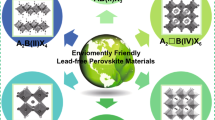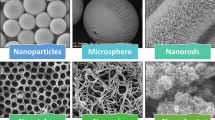Abstract
Dye-sensitized solar cells have become in one important and promising technology in the photovoltaic field. The ability for a sensitizer to harvest light photons and inject the excited electrons into a photoanode, typically a metal oxide, determines the performance and operation range of the solar cell. Metal complexes with 1,3-dithiole-2-thione-4,5-dithiolate (dmit) ligands, which are an important class of functional materials, have received extensive attention due to their intriguing chemical and physical properties. The electronic and molecular properties of isolated and adsorbed nickel complexes with dmit ligands have been investigated using first-principles calculations based on the density functional theory (DFT). Adsorption energies of metal complexes supported on the anatase TiO2(101) surface were calculated for three different configurations, linked by sulfur atom of Sthione, Sthiole–Sthiolate, and planar. The most stable adsorption configurations found in this study are the Sthiole–Sthiolate and the planar forms for the nickel complex. TD-DFT molecular calculations reveal that the lowest energy transition in ultraviolet visible near-infrared (UV–Vis-NIR) mainly corresponds to the HOMO–LUMO π–π* excitation for the nickel complex. The effect of the TiO2 (101) surface on the absorption spectra of the nickel complex is practically limited to a red shift of about 0.1–0.3 eV. The analysis of the density of states for the dmit/TiO2 (101) system shows that the LUMO of the metal complex lies at the edge of the TiO2 conduction band indicating, therefore, that electron injection from the complex excited state into the semiconductor surface is unlikely.







Similar content being viewed by others
References
Nazeeruddin MK, Baranoff E, Grätzel M (2011) Dye-sensitized solar cells: a brief overview. Sol Energy 85:1172–1178
Hagfeldt A, Boschloo G, Sun L, Kloo L, Pettersson H (2010) Dye-sensitized solar cells. Chem Rev 110:6595–6663
Robertson N (2006) Optimizing dyes for dye-sensitized solar cells. Angew Chem Int Edit 45:2338–2345
Lupan O, Guérin VM, Tiginyanu IM, Ursaki VV, Chow L, Heinrich H, Pauporté T (2010) Well-aligned arrays of vertically oriented ZnO nanowires electrodeposited on ITO-coated glass and their integration in dye sensitized solar cells. J Photoch Photobio A 211:65–73
Sakai N, Miyasaka T, Murakami TN (2013) Efficiency enhancement of ZnO-based dye-sensitized solar cells by low-temperature TiCl4 treatment and dye optimization. J Phys Chem C 117:10949–10956
Han DW, Heo JH, Kwak DJ, Han CH, Sung YM (2009) Texture, morphology and photovoltaic characteristics of nanoporous F:SnO2 films. J Electr Eng Technol 4:93–97
Ferrere S, Zaban A, Gregg BA (1997) Dye sensitization of nanocrystalline Tin oxide by perylene derivatives. J Phys Chem B 101:4490–4493
Niu H, Zhang S, Wang R, Guo Z, Shang X, Gan W, Qin S, Wan L, Xu J (2014) Dye-sensitized solar cells employing a multifunctionalized hierarchical SnO2 nanoflower structure passivated by TiO2 nanogranulum. J Phys Chem C 118:3504–3513
Nazeeruddin MK, De Angelis F, Fantacci S, Selloni A, Viscardi G, Liska P, Ito S, Takeru B, Grätzel M (2005) Combined experimental and DFT-TDDFT computational study of photoelectrochemical cell ruthenium sensitizers. J Am Chem Soc 127:16835–16847
Yella A, Lee HW, Tsao HN, Yi C, Chandiran AK, Nazeeruddin MK, Diau EWG, Yeh CY, Zakeeruddin SM, Grätzel M (2011) Porphyrin-sensitized solar cells with cobalt (II/III)–based redox electrolyte exceed 12 percent efficiency. Sci 334:629–634
Diwan K, Chauhan R, Singh SK, Singh B, Drew MGB, Bahadur L, Singh N (2014) Light harvesting properties of some new heteroleptic dithiocarbimate-diamine/diimine complexes of Ni, Pd and Pt studied as photosensitizer in dye-sensitized TiO2 solar cells. New J Chem 38:97–108
Linfoot CL, Richardson P, McCall KL, Durrant JR, Morandeira A, Robertson N (2011) A nickel-complex sensitiser for dye-sensitised solar cells. Sol Energy 85:1195–1203
Duchanois T, Thibaud E, Cebrián C, Lui L, Monari A, Baley M, Assfeld X, Haacke S, Gross PC (2015) An iron-based photosensitizer with extended excited-state lifetime: photophysical and photovoltaic properties. Eur J Inorg Chem 14:2469–2477
Duchanois T, Etienne T, Beley M, Assfeld X, Perpète EA, Monari A, Gros PC (2014) Heteroleptic pyridyl-carbene iron complexes with tuneable electronic properties. Eur J Inorg Chem 23:3747–3753
Islam A, Sugihara H, Hara K, Singh LP, Katoh R, Yanagida M, Takahashi Y, Murata S, Arakawa H, Fujihashi G (2001) Dye sensitization of nanocrystalline titanium dioxide with square planar platinum(II) diimine dithiolate complexes. Inorg Chem 40:5371–5380
Geary EAM, Yellowlees LJ, Jack LA, Oswald IDH, Parsons S, Hirata N, Durrant JR, Robertson N (2005) Synthesis, structure, and properties of [Pt(II)(diimine)(dithiolate)] dyes with 3,3‘-, 4,4‘-, and 5,5‘-disubstituted bipyridyl: applications in dye-sensitized solar cells. Inorg Chem 44:242–250
Geary EAM, McCall KL, Turner A, Murray PR, McInnes EJL, Jack LA, Yellowlees LJ, Robertson N (2008) Spectroscopic, electrochemical and computational study of Pt-diimine-dithiolene complexes: rationalising the properties of solar cell dyes. Dalton T:3701–3708
Lazarides T, McCormick TM, Wilson KC, Lee S, McCamant DW, Eisenberg R (2011) Sensitizing the sensitizer: the synthesis and photophysical study of bodipy−Pt(II)(diimine)(dithiolate) conjugates. J Am Chem Soc 133:350–364
Browning C, Hudson JM, Reinheimer EW, Kuo FL, McDougaldJr RN, Rabaâ H, Pan H, Bacsa J, Wang X, Dunbar KR, Shepherd ND, Omary MA (2014) Synthesis, spectroscopic properties, and photoconductivity of black absorbers consisting of Pt(bipyridine)(dithiolate) charge transfer complexes in the presence and absence of nitrofluorenone acceptors. J Am Chem Soc 136:16185–16200
Kato R (2004) Conducting metal dithiolene complexes: structural and electronic properties. Chem Rev 104:5319–5346
Zarkadoulas A, Koutsouri E, Mitsopoulou CA (2012) A perspective on solar energy conversion and water photosplitting by dithiolene complexes. Coord Chem Rev 256:2424–2434
Frisch MJ, Trucks GW, Schlegel HB, Scuseria GE, Robb MA, Cheeseman JR, Scalmani G, Barone V, Mennucci B, Petersson GA, Nakatsuji H, Caricato M, Li X, Hratchian HP, Izmaylov AF, Bloino J, Zheng G, Sonnenberg JL, Hada M, Ehara M, Toyota K, Fukuda R, Hasegawa J, Ishida M, Nakajima T, Honda Y, Kitao O, Nakai H, Vreven T, Montgomery Jr JA, Peralta JE, Ogliaro F, Bearpark M, Heyd JJ, Brothers E, Kudin KN, Staroverov VN, Keith T, Kobayashi R, Normand J, Raghavachari K, Rendell A, Burant JC, Iyengar SS, Tomasi J, Cossi M, Rega N, Millam JM, Klene M, Knox JE, Cross JB, Bakken V, Adamo C, Jaramillo J, Gomperts R, Stratmann RE, Yazyev O, Austin AJ, Cammi R, Pomelli C, Ochterski JW, Martin RL, Morokuma K, Zakrzewski V G, Voth GA, Salvador P, Dannenberg JJ, Dapprich S, Daniels AD, Farkas O, Foresman JB, Ortiz JV, Cioslowski J, Fox DJ, (2010) Gaussian Inc., Wallingford
Lee C, Yang W, Parr RG (1988) Development of the Colle–Salvetti correlation-energy formula into a functional of the electron density. Phys Rev B 37:785
Becke AD (1988) Density-functional exchange-energy approximation with correct asymptotic behavior. Phys Rev A 38:3098
Stevens WJ, Basch H, Krauss M (1984) Compact effective potentials and efficient shared-exponent basis sets for the first- and second-row atoms. J Chem Phys 81:6026
Stevens WJ, Krauss M, Basch H, Jasien PG (1992) Relativistic compact effective potentials and efficient, shared-exponent basis sets for the third-, fourth-, and fifth-row atoms. Can J Chem 70:612–630
Cundari TR, Stevens WJ (1993) Effective core potential methods for the lanthanides. J Chem Phys 98:5555
Yanai T, Tew DP, Handy NC (2004) A new hybrid exchange-correlation functional using the coulomb-attenuating method (CAM-B3LYP). Chem Phys Lett 393:51
Kresse G, Hafner J (1993) Ab initio molecular dynamics for liquid metals. Phys Rev B 47:558
Kresse G, Furthmüller J (1996) Efficient iterative schemes for ab initio total-energy calculations using a plane-wave basis set. Phys Rev B 54:11169
Kresse G, Furthmüller J (1996) Efficiency of ab initio total energy calculations for metals and semiconductors using a plane-wave basis set. Comp Mat Sci 6:15–50
Perdew JP, Burke K, Ernzerhof M (1996) Generalized gradient approximation made simple. Phys Rev Lett 77:3865
Dudarev SL, Botton GA, Savrasov SY, Humphreys CJ, Sutton AP (1998) Electron-energy-loss spectra and the structural stability of nickel oxide: an LSDA + U study. Phys Rev B 57:1505
Calzado CJ, Hernández NC, Sanz JF (2008) Effect of on-site Coulomb repulsion term U on the band-gap states of the reduced rutile (110) TiO2 surface. Phys Rev B 77:045118
Cao C, Hill S, Cheng HP (2008) Strongly correlated electrons in the [Ni(hmp)(ROH)X]4 single molecule magnet: a DFT + U study. Phys Rev Lett 100:167206
Gajdoš M, Hummer K, Kresse G, Furthmüller J, Bechstedt F (2006) Linear optical properties in the projector-augmented wave methodology. Phys Rev B 73:045112
Klimeš J, Bowler DR, Michaelides A (2011) Van der Waals density functionals applied to solids. Phys Rev B 83:195131
Breitzer JG, Rauchfuss TB (2000) Studies on α-C3S5 2− (dmit2−) and its dinuclear Ni(II) complex: spectroscopic and structural characterization. Polyhedron 19:1283–2391
Bousseau M, Valade L, Legros JP, Cassoux P, Garbauskas M, Interrante LV (1986) Highly conducting charge-transfer compounds of tetrathiafulvalene and transition metal-”dmit” complexes. J Am Chem Soc 108:1908–1916
Ferreira GB, Comerlato NM, Wardell JL, Hollauer E (2004) Vibrational spectra of bis(dmit) complexes of main group metals: IR, Raman and ab initio calculations. J Braz Chem Soc 15:951–963
Valade L, Legros JP, Cassoux P, Kubel F (1986) Synthesis, electrical conductivity, and crystal structure of (AsPh4)0.25 [Ni(dmit)2]. Mol Cryst Liq Cryst 140:335–351
Singh JD, Singh HB (1993) Synthesis and characterization of [M(dmit)2]2− and [M(dmt)2]2− complexes (M = Se(II) or Te(II); dmit = 4,5-dimercapto-1,3-dithiole-2-thione and dmt = 4,5-dimercapto-1,2-dithiole-3-thione). Polyhedron 12:2849–2856
Liu G, Fang Q, Xu W, Chen H, Wang C (2004) Vibration assignment of carbon–sulfur bond in 2-thione-1,3-dithiole-4,5-dithiolate derivatives. Spectrochim Acta A 60:541–550
Bernardo da Cruz AG, Wardell JL, Rocco AM (2006) The decomposition kinetics of [Et4N]2[M(dmit)2] (M = Ni, Pd) in a nitrogen atmosphere using thermogravimetry. Thermochim Acta 443:217–224
Fan HL, Ren Q, Wang XQ, Li TB, Sun J, Zhang GH, Xu D, Yu G, Sun ZH (2009) Investigation on third-order optical nonlinearities of two organometallic Dmit2- complexes using Z-scan technique. Natural Sci 01:136–141
da Cruz AGB, Wardell JL, Rangel MVD, Simão RA, Rocco AM (2007) Preparation and characterization of a polypyrrole hybrid film with [Ni(dmit)2]2−, bis(1,3-dithiole-2-thione-4,5-dithiolate)nickellate(II). Synthetic Met 157:80–90
Ferreira GB, Hollauer E, Comerlato NM, Wardell JL (2006) An experimental and theoretical study of the electronic spectra of tetraethylammonium [bis(1,3-dithiole-2-thione-4,5-dithiolato)zincate(II)], [NEt4]2[Zn(dmit)2], and tetraethylammonium [bis(1,3-dithiole-2-one-4,5-dithiolato)zincate(II)], [NEt4]2[Zn(dmio)2]. Inorg Chim Acta 359:1239–1247
da Cruz AGB, Wardell JL, Simão RA, Rocco AM (2007) Preparation, structure and electrochemistry of a polypyrrole hybrid film with [Pd(dmit)2]2−, bis(1,3-dithiole-2-thione-4,5-dithiolate)palladate(II). Electrochim Acta 52:1239–1247
Arroyo-de Dompablo ME, Morales-García A, Taravillo M (2011) DFT + U calculations of crystal lattice, electronic structure, and phase stability under pressure of TiO2 polymorphs. J Chem Phys 135:054503–054511
Nadler R, Sanz JF (2013) Simulating the optical properties of CdSe clusters using the RT-TDDFT approach. Theor Chem Acc 132:1342
Nadler R, Sanz JF (2015) Effect of capping ligands and TiO2 supporting on the optical properties of a (CdSe)13. Cluster, J Phys Chem A 119:1218–1227
Amaya Suárez J, Plata JJ, Marquez AM, Sanz JF (2016) Structural, electronic and optical properties of copper, silver and gold sulfide: a DFT study. Theor Chem Acc 135:70
Acknowledgements
The first author would like to acknowledge fellowships granted by CAPES (Coordenação de Aperfeiçoamento de Pessoal de Nível Superior) and CNPq to fund her stay at the University of Seville. Computations were done at the University of Seville facilities funded by Spanish Ministerio de Economía y Competitividad, Grant CTQ2015-64669-P, Junta de Andalucía, Grant P12-FQM-1595, and European FEDER.
Author information
Authors and Affiliations
Corresponding author
Additional information
Published as part of the special collection of articles derived from the 10th Congress on Electronic Structure: Principles and Applications (ESPA-2016).
Rights and permissions
About this article
Cite this article
Paes, L.W.C., Suárez, J.A., Márquez, A.M. et al. First-principles study of nickel complex with 1,3-dithiole-2-thione-4,5-dithiolate ligands as model photosensitizers. Theor Chem Acc 136, 71 (2017). https://doi.org/10.1007/s00214-017-2098-7
Received:
Accepted:
Published:
DOI: https://doi.org/10.1007/s00214-017-2098-7




